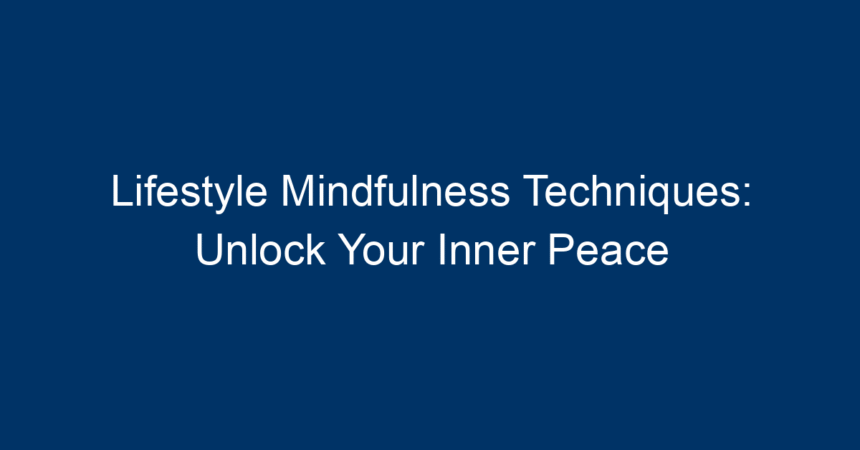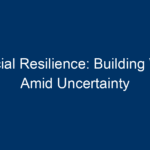In today’s fast-paced world, finding a moment of tranquility often feels impossible. Between work deadlines, family responsibilities, and the constant buzz of technology, stress can creep in, leaving us feeling overwhelmed. This is where lifestyle mindfulness techniques come into play, helping us unlock our inner peace amidst chaos. By incorporating these practices into our daily lives, we can cultivate a sense of awareness and tranquility that promotes mental clarity and emotional stability. Let’s explore practical lifestyle mindfulness techniques that can enhance your well-being.
Understanding Mindfulness
At its core, mindfulness is about being present. It involves tuning into your thoughts, feelings, and the environment around you without judgment. This heightened awareness can transform ordinary moments into opportunities for peace. Research shows that practicing mindfulness can reduce stress, improve concentration, and enhance emotional health.
Benefits of Mindfulness
- Stress Reduction: Regular mindfulness practices can lower cortisol levels, the stress hormone, thereby reducing anxiety.
- Enhanced Focus: Mindfulness helps to improve concentration, making it easier to complete tasks efficiently.
- Emotional Regulation: Through mindfulness, individuals learn to respond to their emotions rather than react impulsively.
- Improved Relationships: Being mindful fosters better communication and empathy, enriching personal connections.
Lifestyle Mindfulness Techniques to Practice
1. Mindful Breathing
What Is It?
Mindful breathing is a fundamental mindfulness technique that centers on the breath as a point of focus. This simple practice can be performed anywhere—at your desk, during a walk, or in a quiet space at home.
How to Practice:
- Find a Comfortable Position: Sit or lie down in a relaxing position.
- Close Your Eyes: If comfortable, close your eyes to eliminate distractions.
- Focus on Your Breath: Take a deep inhale through your nose, holding for a moment, and then exhale slowly through your mouth.
- Repeat: Continue this process for a few minutes, focusing solely on the sensation of your breath.
2. Cultivating Gratitude
What Is It?
Gratitude is more than just a polite habit; it’s a lifestyle choice that can significantly boost your mood and overall well-being. Keeping a gratitude journal can be a transformative mindfulness practice.
How to Practice:
- Daily Reflections: Each day, write down three things you’re grateful for in a journal. They can be as significant as a promotion at work or as small as a warm cup of coffee on a chilly morning.
- Express Appreciation: Take time to express thanks to people who have impacted your life. Whether through a note or a heartfelt conversation, this act fosters connection and positivity.
3. Mindful Eating
What Is It?
Mindful eating transforms the way you experience food, encouraging you to savor every bite and appreciate the nourishment it brings.
How to Practice:
- Slow Down: During meals, put away distractions like your phone or television.
- Pay Attention to Flavors: Focus on the textures and tastes of each bite, noticing how it feels in your mouth.
- Listen to Your Body: Eat until you’re satisfied, not until you’re full. This mindful approach helps you maintain a healthy relationship with food.
4. Nature Walks
What Is It?
Spending time in nature is a powerful mindfulness technique. Nature walks not only promote physical health but also reduce stress and enhance focus.
How to Practice:
- Choose a Scenic Route: Find a nearby park or nature trail.
- Engage Your Senses: As you walk, notice the sights, sounds, and smells around you. Feel the ground beneath your feet and the breeze on your skin.
- Practice Walking Meditation: Walk slowly and deliberately, focusing your attention solely on the act of walking.
5. Guided Meditations
What Is It?
Guided meditation involves listening to a teacher or a recorded session that walks you through a meditation practice. This is especially beneficial for beginners.
How to Practice:
- Find a Comfortable Space: Choose a quiet area where you won’t be disturbed.
- Use Apps or Videos: Platforms like Headspace or YouTube offer guided sessions tailored to various needs.
- Set a Time Limit: Start with 5-10 minutes and gradually increase your practice time as you become more comfortable.
Integrating Mindfulness into Daily Life
1. Create Mindful Routines
Incorporate mindfulness into your daily routines. This might involve waking up early for a few moments of meditation or practicing mindful breathing during your commute. By embedding mindfulness into everyday activities, you create a lifestyle of awareness.
2. Practice Digital Detox
Technology can often exacerbate stress and distract us from being present. Implementing a digital detox by setting boundaries for screen time can significantly contribute to your mindfulness practice. Designate tech-free times during the day to reconnect with yourself and your surroundings.
3. Make Mindfulness a Group Activity
Invite friends or family to join you in mindfulness practices. Whether it’s a group meditation, a mindful eating session, or a nature walk, shared experiences can enhance your commitment to mindfulness.
Overcoming Challenges in Mindfulness Practice
1. Embracing Imperfection
It’s important to remember that mindfulness is not about achieving a perfect state of calm. It’s about embracing the present moment—imperfections included. Acknowledge your thoughts without judgment and allow yourself to be human.
2. Setting Realistic Goals
If you’re new to mindfulness, start small. Set manageable goals that fit your lifestyle. Gradually increase the time and frequency of your practices as you become more comfortable.
Conclusion: Actionable Insights
Incorporating lifestyle mindfulness techniques into your daily routine can significantly transform your mental and emotional well-being. By practicing mindful breathing, cultivating gratitude, engaging in mindful eating, enjoying nature walks, and utilizing guided meditations, you can unlock your inner peace. Begin by implementing one technique today, and gradually incorporate more as you feel ready. Remember: mindfulness is a journey, not a destination. Embrace each moment and enjoy the profound changes that come with living mindfully.
By making these techniques part of your lifestyle, you’ll not only enhance your own well-being but also inspire those around you to pursue their path to peace.




